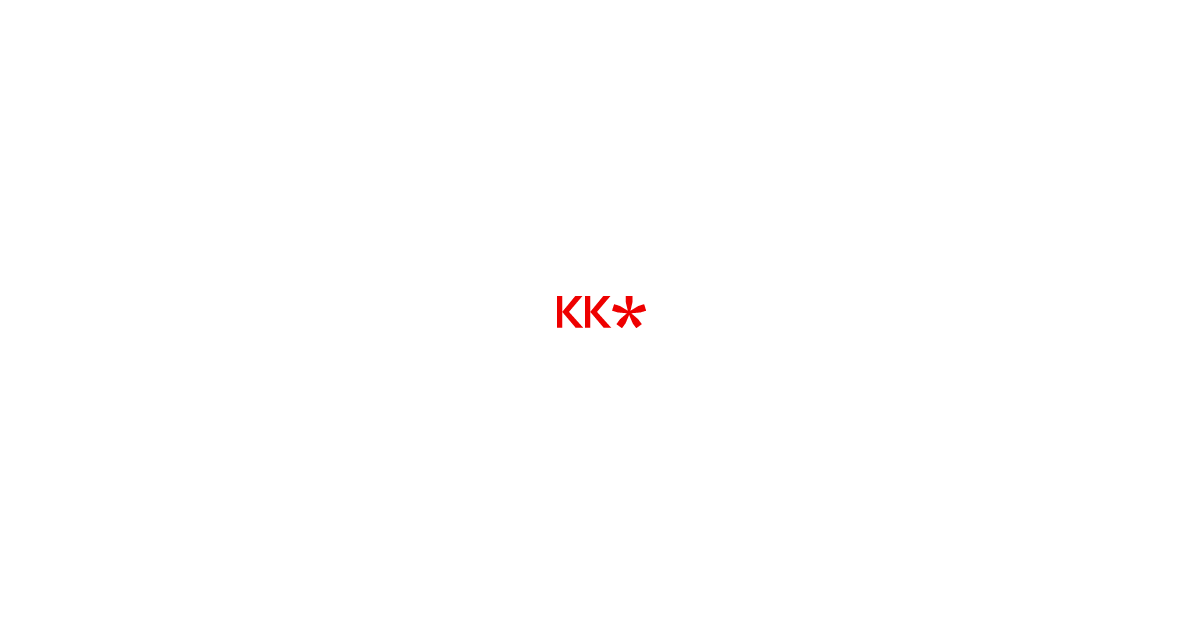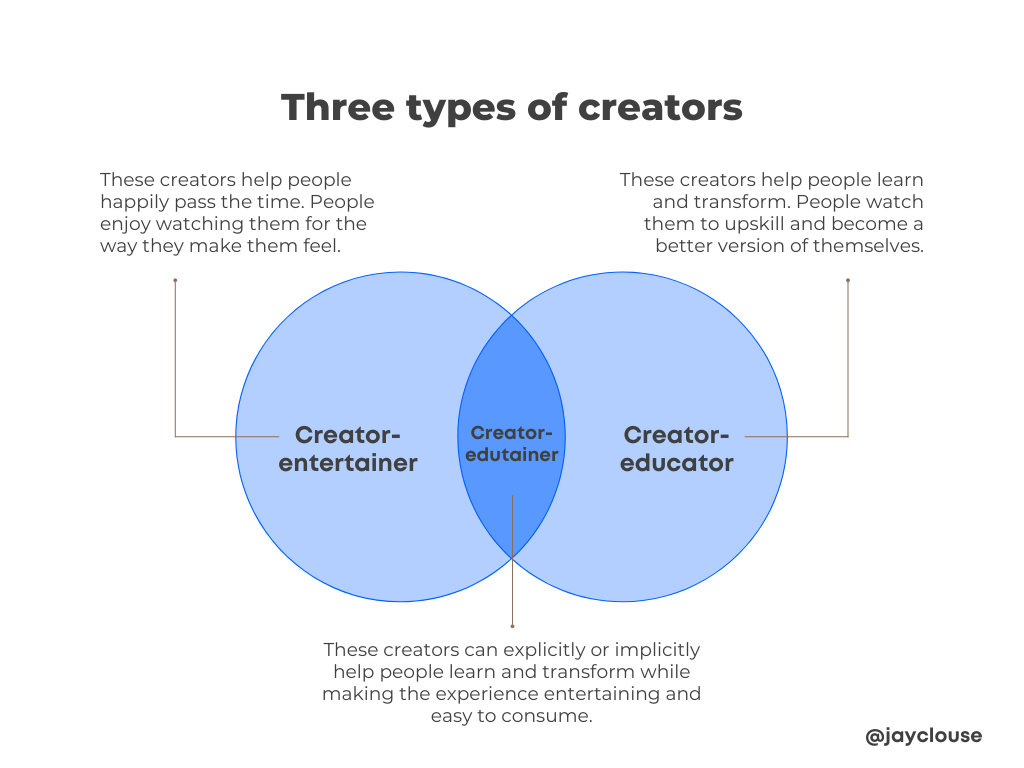Ever since the term "creator economy" was coined, I've resisted it.
I care about the creator opportunity. I care about the creator movement. And I do believe it's never been easier to turn your earned insight into an independent income.
But when people talk about the "creator economy," I usually roll my eyes. Most of the "creator economy" attention is directed toward the top end of the spectrum – creators with the largest audiences. Creators like MrBeast, Emma Chamberlain, Charli D'Amelio, and Logan Paul.
These creators have done incredible things. They've really blazed a new trail for capturing attention and building a media brand. But is that opportunity possible for millions of people?
I don't think so. And neither does Logan Paul.
The reality is, today's biggest creators are just a new breed of celebrity. They're entertainers.
Do we believe that the creator economy will meaningfully expand the number of A-list celebrities, or just spin the revolving door more quickly?
My bet is on the latter.
As these creators grow larger and larger, I think we'll see them simply enter the pre-existing (but evolving) world of show business. After all, those businesses will need to evolve, and they've built systems to fund and distribute work for decades – and what more would a creator at the highest level want?
So are the MrBeasts of the world really the best models for people who want to participate in the creator economy?
Nope.
I think we've missed the mark on the true opportunity of the creator economy – and those who are best positioned to take advantage of this new world aren't getting the respect they deserve.
Too much emphasis and attention is placed on creator-entertainers and not enough is placed on the creator-educators. Independent creators not taking on legacy media, but legacy education.
But first, some background...
What is the creator economy?
The creator economy refers to the businesses run by more than 50 million independent content creators as well as the platforms and tools supporting those creators.
It's a broad definition, but it fits.
There have always been creators – artists, speakers, comedians, etc. But for most of human history, those creators had a very tough time effectively earning an independent living from their work and instead had to be chosen by gatekeepers. Those gatekeepers may have been art curators, music labels, publishers, distributors, etc.
It's only recently that better tooling through the internet has allowed creators to publish independently, distribute widely, and gain attention all for a nominal cost.
Paul Saffo is a professor in the School of Engineering at Stanford University teaching courses on the future of engineering and the impact of technological change on the future. In fact, he's a futurist!
If you have the time, I really recommend you watch his breakdown of how the Creator Economy came to be (and what may come next).
Underlying (and ignored) assumptions
In 2008, Kevin Kelly wrote an article called 1,000 True Fans. It's a legendary, important piece of writing that I'd be shocked if you hadn't heard of before.
But have you actually read it?

Here's an important excerpt (emphasis mine):
To be a successful creator you don’t need millions. You don’t need millions of dollars or millions of customers, millions of clients or millions of fans. To make a living as a craftsperson, photographer, musician, designer, author, animator, app maker, entrepreneur, or inventor you need only thousands of true fans.
A true fan is defined as a fan that will buy anything you produce. These diehard fans will drive 200 miles to see you sing; they will buy the hardback and paperback and audible versions of your book; they will purchase your next figurine sight unseen; they will pay for the “best-of” DVD version of your free youtube channel; they will come to your chef’s table once a month. If you have roughly a thousand of true fans like this (also known as super fans), you can make a living — if you are content to make a living but not a fortune.
Here’s how the math works. You need to meet two criteria. First, you have to create enough each year that you can earn, on average, $100 profit from each true fan. That is easier to do in some arts and businesses than others, but it is a good creative challenge in every area because it is always easier and better to give your existing customers more, than it is to find new fans.
Second, you must have a direct relationship with your fans. That is, they must pay you directly. You get to keep all of their support, unlike the small percent of their fees you might get from a music label, publisher, studio, retailer, or other intermediate. If you keep the full $100 of each true fan, then you need only 1,000 of them to earn $100,000 per year. That’s a living for most folks.
There are some important details in Kevin's writing here that a lot of people (inconveniently) gloss over:
- A true fan is someone who will buy anything you produce
- This model earns you a living (not a fortune)
- You want to earn $100 profit from each fan
- You need a direct relationship with the fans
Napkin math
Most creators simplify this in their mind as "I need 1,000 people who will buy something from me" (ignoring true fandom).
They also imagine that something is a $100 product (ignoring expenses).
And many creators are still focused on monetizing indirectly through third-party platforms (ignoring the direct sales relationship).
As a result, creators quickly discover several harsh realities:
Just getting 1,000 viewers is hard
While 1,000 true fans sounds achievable enough, beginning creators soon experience the challenge of simply getting 1,000 people to pay attention.
How big is your overall audience right now?
It took me years to reach 1,000 email subscribers.
I was recently told it typically takes more than two years and hundreds of videos for YouTubers to reach 1,000 subscribers.
And these are FREE subscribers.
What percentage of your subscribers do you estimate are true fans by Kevin Kelly's definition? Remember, the idea here is that they would purchase anything you make.
I would bet it's small. Definitely less than 10% – and 10% is high. But let's assume 10% of your audience can be made into a true fan – now you're talking about an overall audience need of 10,000.
If we look at this analysis from Patreon:
If a YouTube creator has 30,000 subscribers, and 15% of those subscribers are super passionate, then they’re likely to click through a video end card promoting the creator’s Patreon page, which means 4,500 people primed for patronage. However, not all 4,500 of those individuals will become patrons, in fact, typically 1-5% of those fans might convert to patrons (in this case, 45-225 people).
The reasons why people convert vary. It could be the structure of the Patreon page or the value of the membership offering, or it could be a cut-and-dry financial situation on the patron’s side.
Now, let’s say that creator has reward tiers that are valued at $2, $5, $10, $25, and $100. If most patrons pledge $2-10, it’s likely the average patron will pay roughly $7. The creator could hope to earn $315 on the low end and $1575 on the high end following the first promotion of their page.


That's an estimate of 1-5% conversion on people who went so far as to learn more. And that conversion is for an assumed $7 purchase.
$100 is not a small purchase
Netflix is $10-20 per month.
A Starbucks coffee is about $5.
If you want to earn $100 (in profit) from a customer, you need to create something that's a perceived value 5-10x that of a monthly Netflix subscription.
Revenue is only half of the equation
Remember, Kevin Kelly said that you need to earn $100 profit from each fan.
profit = revenue - expenses
Depending on what you're selling, you need to factor in your Cost Of Goods (COGs). If you're selling a $60 hoodie with your brand, how much was your COGs? What about shipping and handling?
Digital products make this a lot easier, but you may still have technology costs or the cost of your time as fulfillment.
Getting 1,000 customers is even harder
As difficult as it is to get ONE customer who will pay north of $100 for something, now you need to do that 1,000 times over.
Using that same Patreon math, you're looking at 20,000-100,000 casual fans to achieve 1,000 customers.
1,000 customers ≠ 1,000 true fans
Let's say you have 20,000-100,000 casual fans that net you 1,000 customers...that still doesn't make them a true fan who would make a similar or greater purchase the next year! There will be some natural amount of customer churn.
Sponsored ad revenue can be fickle
A lot of creators look to sponsorships and brand deals to help them get around these challenges entirely. And that's a totally viable model – especially when advertising budgets are flush with cash.
Sponsors typically have really strong, attractive products. Not only that, they've likely gotten good at selling them too – provided they get initial attention.
That's where a lot of creators come in – they add potential customers to the top of the funnel for these brands.
But this ties your success and livelihood to the budgets (and desires) of brands, which fundamentally gives up some level of control.
It certainly doesn't satisfy Kevin Kelly's direct relationship requirement.
And what happens if/when those budgets dry up?
Well, according to LinkTree's 2022 Creator Report, 67% of creators haven't experienced a brand partnership. And of the 33% that have, 12% earned <$100:

$100,000 in revenue doesn't go far
Building a business that supports the attention of thousands of people almost always comes with a cost. That may be paying a team to help create or manage content, paying for technology to support the business, or any number of other ways creators invest in their business.
I'm a huge proponent of Profit First accounting. Every dollar that enters the business gets broken down into four Target Allocation Percentages:
- 5% allocated to Profit
- 20% allocated to Operating Expenses
- 25% allocated to Taxes
- 50% allocated to Owner's Compensation
And to be honest, I often choose to allocate less to Owner's Compensation in order to invest more money into Operating Expenses (30/40 vs. 20/50).
But in that model, $100,000 becomes:
- $5,000 Profit
- $20,000 Operating Capital
- $25,000 Taxes
- $50,000 Owner's Compensation
As Kevin said, it's a living – not a fortune.
And it's a small, small number of creators who are even getting there. Back to LinkTree's 2022 Creator Report:

Only 15% of creators earn greater than $50K – and 12% of them consider themselves full-time! I'm guessing that $50K is a Gross Revenue figure too.
Managing these realities – actually achieving these (hard) milestones and pushing beyond them – requires a talented, headstrong person with a wide array of skills:
- Earned insight
- Writing or speaking ability
- Comfort on camera
- Technical competency
- Discipline
- Business acumen
- Financial literacy
- Hiring efficacy
...just to name a few of the essentials!
It's all certainly learnable and achievable – it's entrepreneurship.
And that's the rub...
The creator economy promises opportunity for a LOT of creators – but fundamentally requires creators to be entrepreneurs.
Just because there's a new path toward entrepreneurship in the creator economy doesn't mean that people are suddenly more equipped (or interested) in becoming entrepreneurs – especially in those difficult, critical first few years.
While entrepreneurship has high financial upside, it's also one of the hardest paths to make work.
Three types of creators
Not all creators are...created...equal. In fact, there are three main types of creators with two core business models:

Creator-entertainers
These creators are focused on entertainment. They want you to enjoy their content, happily pass the time, and generally provide an escape for the audience.
Their business model is predicated on larger audiences, time spent together, and creating value for third parties (advertisers or platforms like YouTube or Social Media).
These creators are competing for the leisure part of your day – competing with Netflix, Hulu, Disney+, etc.
Main monetization opportunities:
- Advertising and sponsorship (third party)
- Licensing (third party)
- Platform creator funds (third party)
- Affiliate revenue (third party)
- Physical products like merchandise (high COGs)
- Lower-priced memberships/patronage
Examples: MrBeast, Charli D'Amelio, Emma Chamberlain, Logan Paul
Creator-educators
These creators are focused on education and knowledge transfer. They want you to upskill, increase competency, and help their audiences grow and improve.
Their business model is predicated on helping their audience achieve tangible transformation and potentially even a financial return on investment. These businesses typically have smaller audiences, but also lower cost of goods, higher lifetime value, and are far less reliant on creating value for third parties.
These creators are competing with the time you spend working, learning in class or at school, getting better, or trying to learn new skills.
Main monetization opportunities:
- Digital products (templates, downloadables)
- Workshops
- Self-paced digital courses
- Cohort-based courses
- Community-powered course
- Higher-priced memberships
- Affiliate revenue (third party)
- Advertising and sponsorship (third party)
Examples: Justin Welsh, Grammar Girl, Tim Urban, James Clear
Creator-edutainers
These creators are unicorns. All creator-educators still need to meet some baseline of watch-ability, but creator-edutainers package transformation and knowledge transfer into entertainment value.
These creators have the best of both worlds – they have the more efficient monetization opportunities of creator-educators while attracting a larger audience like creator-entertainers.
An incredible example of this is Webflow University's training library. I can't believe how effective they are at training while also being hilarious.
Of course, we'd probably all love to simply choose this path, but it's a rare individual that can combine entertainment with delivering meaningful transformation.
Examples: Ali Abdaal, Alex Hormozi, Miss Excel, Masterclass
The real creator opportunity
If your goal is to earn a reliable living through a direct relationship with your audience, it's a much shorter and less tumultuous path for creator-educators.
The math is pretty straightforward. There is a ton of precedent for creators to turn their earned insight into cash by helping others achieve transformation.
Self-paced online courses sell anywhere from $20 on third-party marketplaces like Udemy to upwards of $1,000 (e.g. Mastering ConvertKit).
Cohort-based courses often range from $500 - $6,000 (e.g. Write Of Passage).
Some mastermind or community programs sell for tens of thousands of dollars.
...and all of these are direct sales relationships with your audience.
Creator-educators can blow past the $100 profit/customer framework. As Li Jin writes, creators (creator-educators) can likely achieve the same success with 100 true fans.


That means that as a creator-educator, not only can you quickly realize the promise of the creator economy and earn a living, but you can also build a very large business as your audience scales.
If you earn $1,000 from 100 customers per year, that gets you to the $100,000 figure. But if you double your reach to 200 customers the next year, that's $200,000, and so on and so on.
There are 20 million college students enrolled in the United States today – the highest enrollment ever.
And, as I'm sure you know, higher education isn't cheap! Take a look at the average tuition and fees of US-based colleges per student, per year:

While college tuitions continue to rise, our trust in institutions is falling.
And at the same time, many employers are changing their hiring practice to remove college degree requirements.
I'll be the first to say that there are fantastic colleges out there that provide some of the best education on the planet.
...but 20 million students can't attend the Ivy League every year.
How long will that many students choose to take predatory loans to attend a university that offers a worse education than can be found much cheaper or even free online?
Especially as employers loosen their requirements for higher ed?
And what about the rest of the population who simply want to learn, upskill, or move into a new vocation?
The face of education is changing – and creators are becoming that new face.
That's the real opportunity of the creator economy. And it's just getting started.




